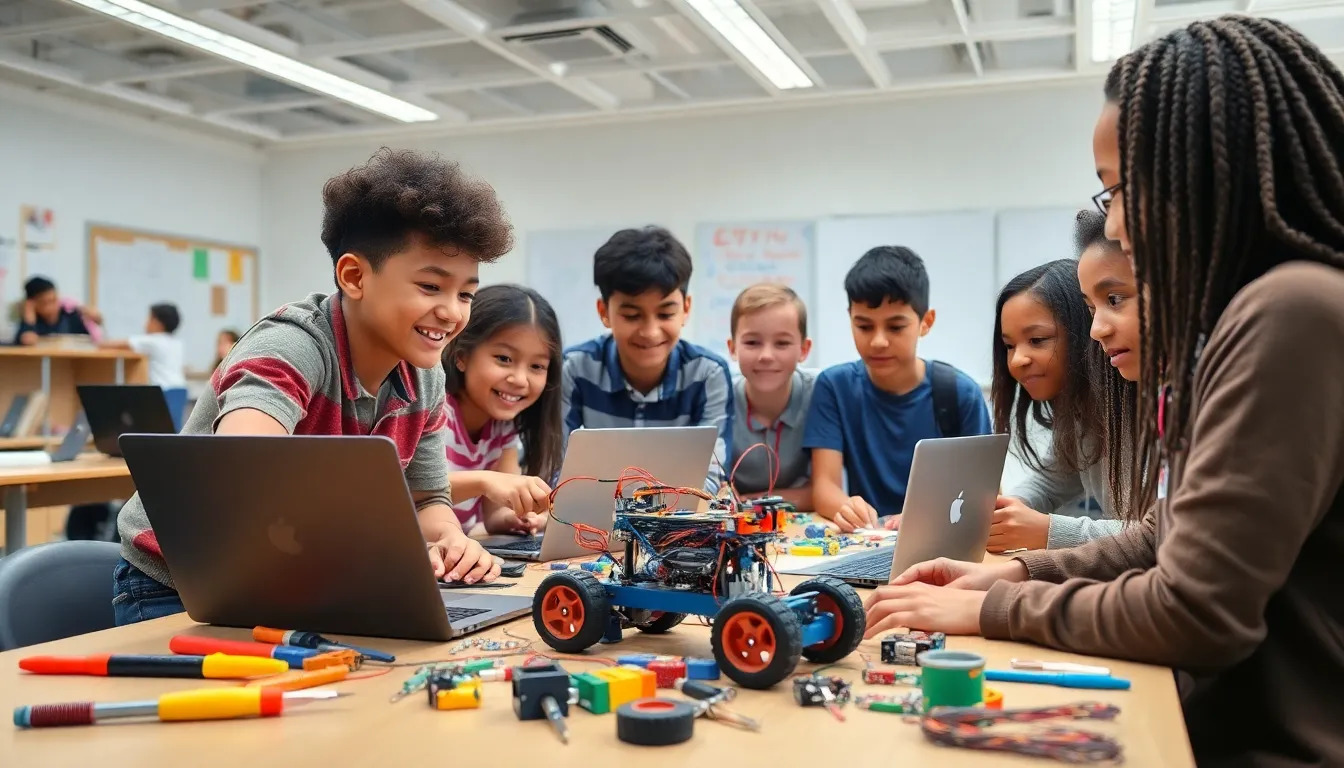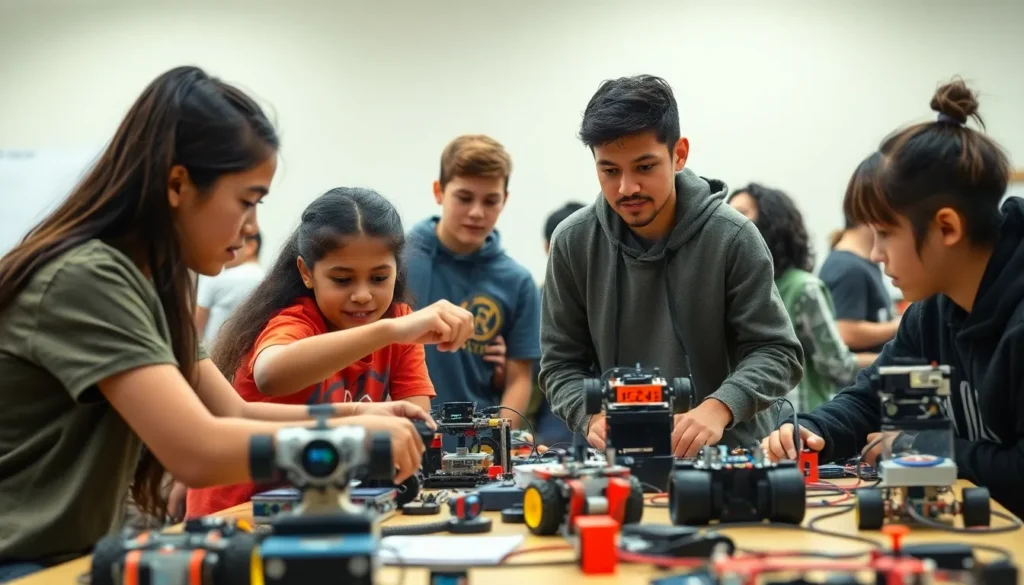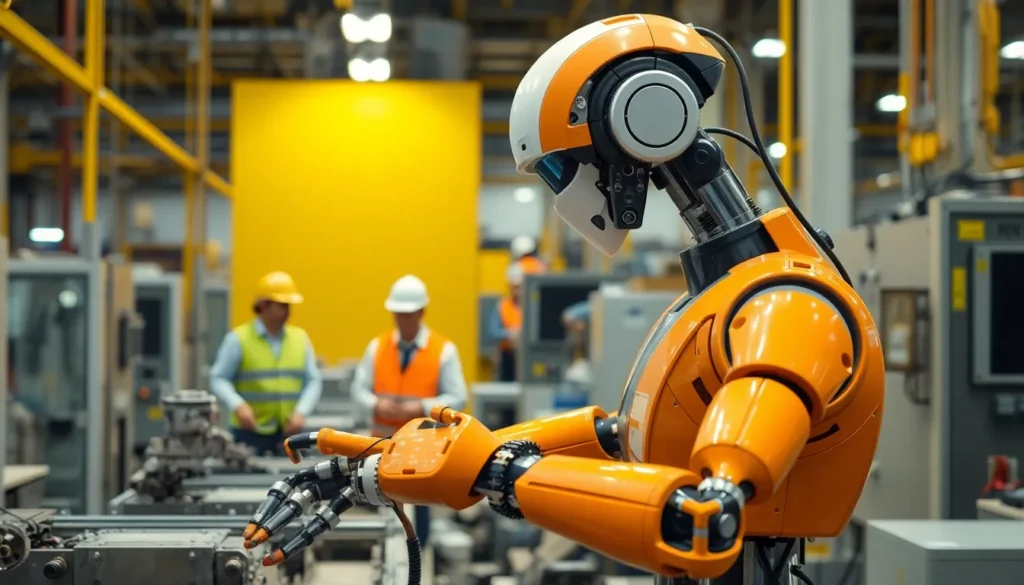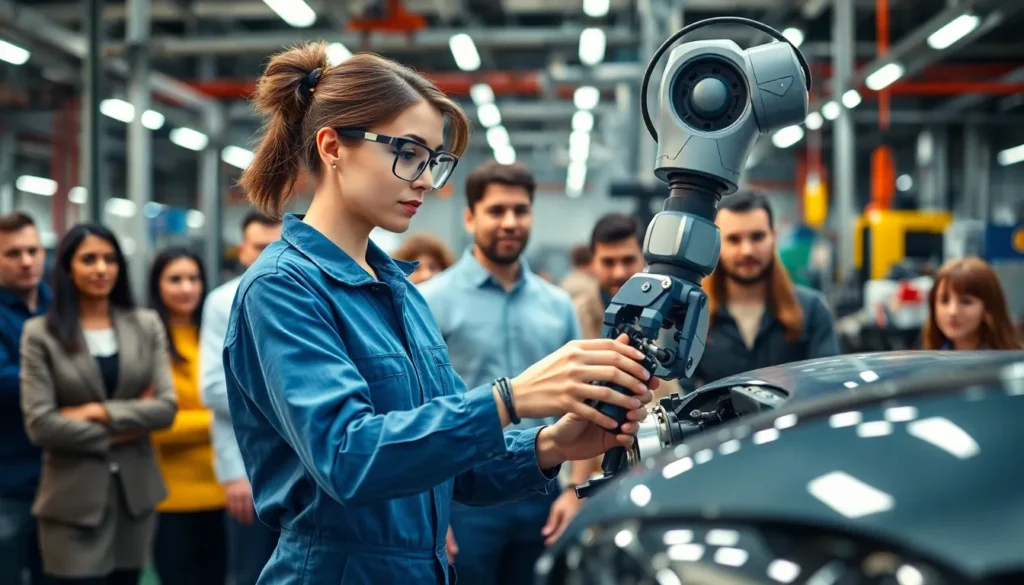In a world where robots are no longer confined to sci-fi movies, the fusion of robotics and coding is transforming how we interact with technology. Imagine a future where your coffee machine knows your morning routine better than you do. That’s not just a dream; it’s the reality that coding and robotics are building.
Robotics and Coding
Robotics and coding combine to create innovative solutions in various industries. Robots perform repetitive tasks while coding provides the necessary instructions for operation. Advancements in artificial intelligence enhance the capabilities of robots, allowing them to learn and adapt over time.
The integration of coding into robotics fosters creativity in problem-solving. Engineers use programming languages like Python and C++ to build autonomous systems. These systems rely on algorithms that enable robots to interpret data, make decisions, and execute tasks efficiently.
Educational institutions focus on teaching robotics and coding to prepare future professionals. Programs introduce students to the fundamentals of both fields, encouraging hands-on projects. Competitions often showcase student-built robots, promoting collaboration and skill development.
Industries leverage robotics and coding for improved efficiency and accuracy. Manufacturing sectors utilize robotic arms for assembly lines, cutting production time significantly. In healthcare, robots assist in surgeries, minimizing human error and enhancing patient outcomes.
The future promises further integration of robotics and coding into daily life. Home automation systems will learn user preferences, streamlining routines. Businesses will increasingly adopt these technologies, transforming operations and enhancing productivity on a large scale.
Importance of Robotics in Education

Robotics in education shapes how students engage with technology, making learning interactive and stimulating.
Engaging Students in STEM
Hands-on experiences with robotics spark interest in STEM subjects. Students interact directly with engineering concepts, boosting their analytical skills. Competitions encourage teamwork and problem-solving, with students collaborating to build functional robots. Creativity thrives as they design and program unique projects, fostering a sense of accomplishment and pride. Events like robotics tournaments showcase their achievements, inspiring others to explore tech fields. Exposure to technology motivates students to consider careers in science and engineering, leading to greater diversity in these industries.
Skill Development Through Robotics
Robotics develops various technical and soft skills crucial for today’s job market. Programming enhances logical thinking, as students must troubleshoot and optimize code. Collaboration builds communication and teamwork abilities when functioning in groups. Critical thinking gets sharpened as learners troubleshoot issues during project development. Students also develop adaptability, with the need to modify their approaches based on project requirements. These competencies prepare students for future challenges, equipping them to thrive in an increasingly technology-driven world.
Coding Fundamentals for Robotics
Coding forms the backbone of robotics, providing the algorithms that enable robots to function effectively. Understanding programming languages and basics equips individuals to innovate in this field.
Programming Languages Used in Robotics
Python stands out as a popular choice due to its simplicity and versatility. C++ provides speed and control, making it ideal for real-time processing. Java offers portability, ensuring programs run across various platforms. Additionally, ROS (Robot Operating System) simplifies complex robotics tasks, facilitating development. Each language serves specific purposes, enabling engineers to choose the right tools for their projects.
Basics of Coding for Beginners
Starting with fundamentals is crucial for newcomers to coding. Variables and data types are foundational elements, defining how data is stored and manipulated. Control structures like loops and conditionals help create logic in programs, guiding decision-making processes. Functions enable code reuse, simplifying complex problems by breaking them down into manageable parts. Beginners can find resources online, such as tutorials and coding platforms, which enhance learning through practical exercises and projects.
Different Applications of Robotics
Robotics plays a vital role across various sectors, driving innovation and transforming everyday experiences. Specific applications highlight how robotics is reshaping multiple fields.
Robotics in Industry
Robots significantly enhance manufacturing processes. They perform tasks such as welding and assembly with precision, which increases productivity. Companies benefit from reduced labor costs and improved safety by deploying robots for repetitive or dangerous jobs. Automation in warehouses streamlines inventory management, with robotic systems handling packaging and sorting, leading to faster order fulfillment. Industries also utilize robotic arms for quality control, ensuring products meet high standards throughout production.
Robotics in Daily Life
Daily life increasingly features robotic technology that simplifies routine tasks. Smart home devices adjust settings based on user behavior. Cleaning robots, for instance, autonomously navigate spaces to vacuum floors, saving time. Additionally, personal assistants like voice-activated devices deliver information and manage schedules, improving convenience. Robotics enhances entertainment options as well, with robotic pets providing companionship and interactive experiences. These innovations contribute to a more efficient and enjoyable lifestyle, showcasing the growing integration of robotics into everyday activities.
Challenges in Robotics and Coding
Robotics and coding face numerous challenges that affect their development and implementation. These hurdles can either stall progress or steer innovation in new directions.
Technical Challenges
Technical challenges often arise during the development of robotic systems. Complex hardware integration poses significant obstacles for engineers; ensuring all components work together seamlessly requires extensive testing. Software bugs frequently cause malfunctions, leading to safety concerns. Real-time processing demands on robotics create latency issues that hinder performance. Additionally, the need for advanced sensors can increase costs; integrating these components complicates design. Adapting to diverse environments remains another hurdle; robots must sense and interpret varied conditions accurately to function effectively.
Ethical Considerations
Ethical considerations play a crucial role in the development of robotics and coding. Transparency in algorithms influences public trust, as users prefer to understand how decisions are made. Privacy concerns arise when robots collect data, prompting discussions on data security and individual rights. Accountability becomes paramount as autonomous systems perform actions without human intervention; defining responsibility for errors is essential. Bias in coding can perpetuate inequalities, putting more emphasis on inclusive programming. Balancing innovation with ethical standards remains essential for fostering public acceptance of these technologies.
Future of Robotics and Coding
Anticipating advancements in robotics and coding showcases the potential of these technologies shaping daily life. Smart appliances, like coffee machines, may become adept at recognizing user preferences, streamlining mundane tasks. Integration of artificial intelligence enhances robots, allowing them to learn from their environments and adjust accordingly.
Educational programs are evolving to prioritize teaching these skills. Robotics classes cultivate innovation, enabling students to design and program their own robots through hands-on experiences. Competitive events foster collaboration while instilling essential skills, such as problem-solving and analytical thinking.
Coding remains integral to robotic functionality. Understanding programming basics equips individuals with the tools to develop and control robotic systems. Common languages such as Python simplify the learning process, while C++ provides speed and control. Java offers portability to various platforms, and the Robot Operating System serves as a foundation for developing complex tasks efficiently.
Industries increasingly adopt robotics to enhance productivity. Manufacturing processes benefit from robotic arms performing repetitive tasks, freeing human workers for more complex duties. In healthcare, surgical robots assist with precision, improving patient outcomes. Daily routines are simplified by smart home devices that respond to user commands.
Challenges persist as robotics and coding advance. Technical hurdles, including software bugs and hardware compatibility issues, can hinder progress. Ethical considerations demand attention, as transparency and accountability in algorithms become paramount. Addressing data privacy and algorithmic bias fosters greater public trust and acceptance of these technologies.
These trends illustrate a promising future where robotics and coding converge, greatly impacting personal and professional realms. Organizations and individuals embracing these innovations position themselves to thrive in a technology-driven society.
Conclusion
Robotics and coding are undeniably reshaping the landscape of technology and education. As these fields continue to evolve, they unlock new possibilities for innovation and efficiency across various sectors. The integration of robotics into daily life enhances convenience while fostering essential skills in future generations.
Embracing these advancements is crucial for both individuals and industries. By prioritizing education in robotics and coding, society can prepare a workforce equipped to tackle emerging challenges. The potential for smart technologies to improve everyday experiences is vast, making it essential to stay informed and engaged in this transformative journey.



